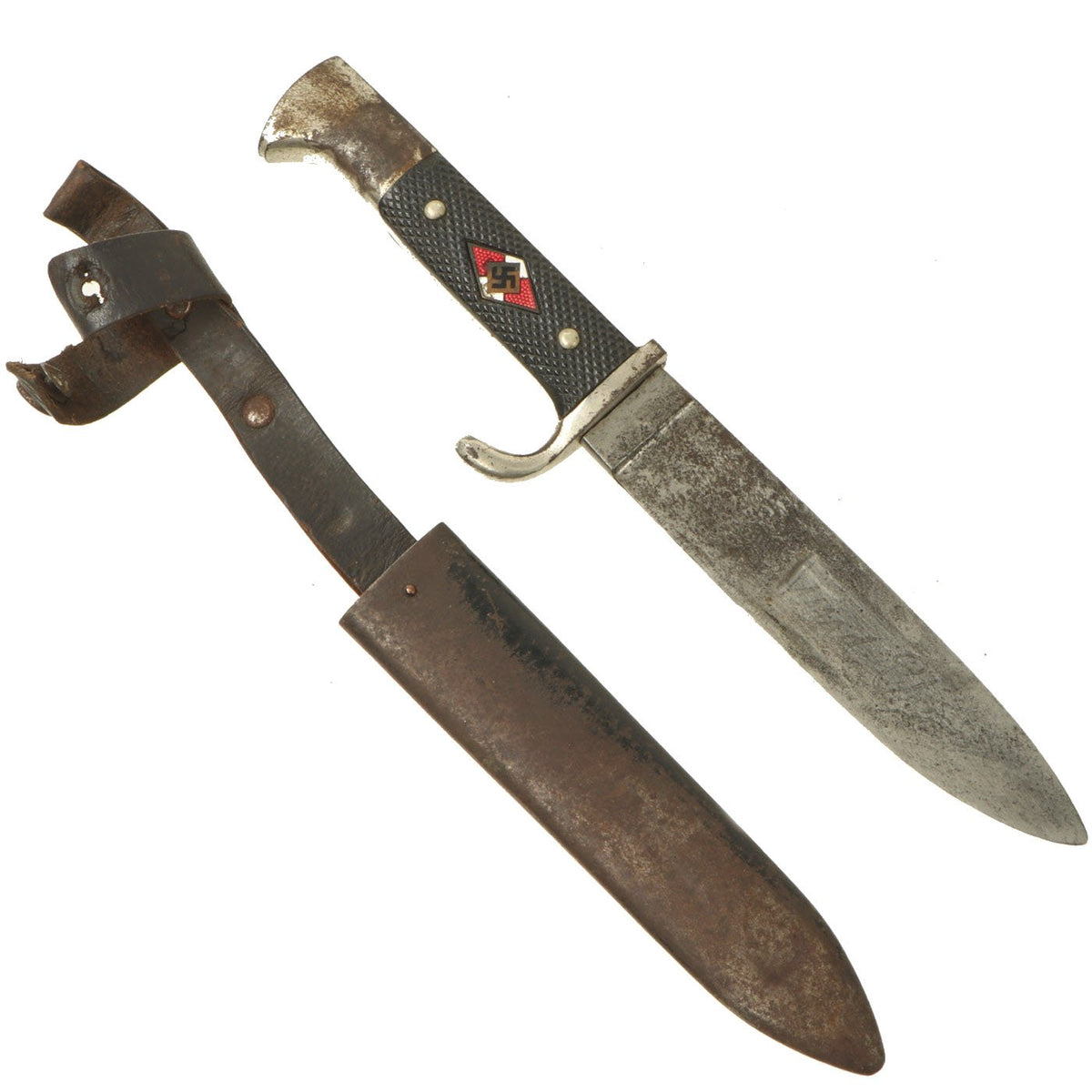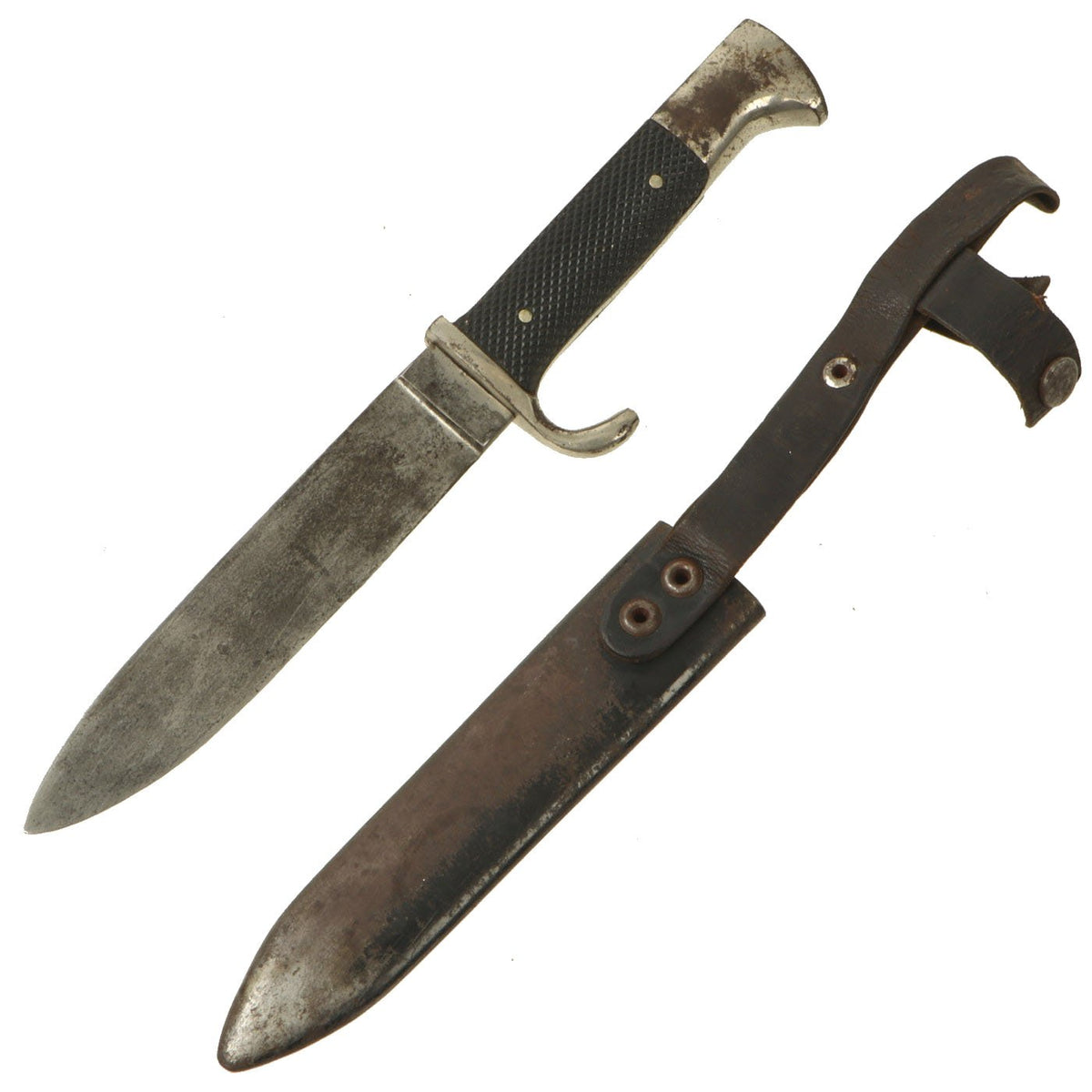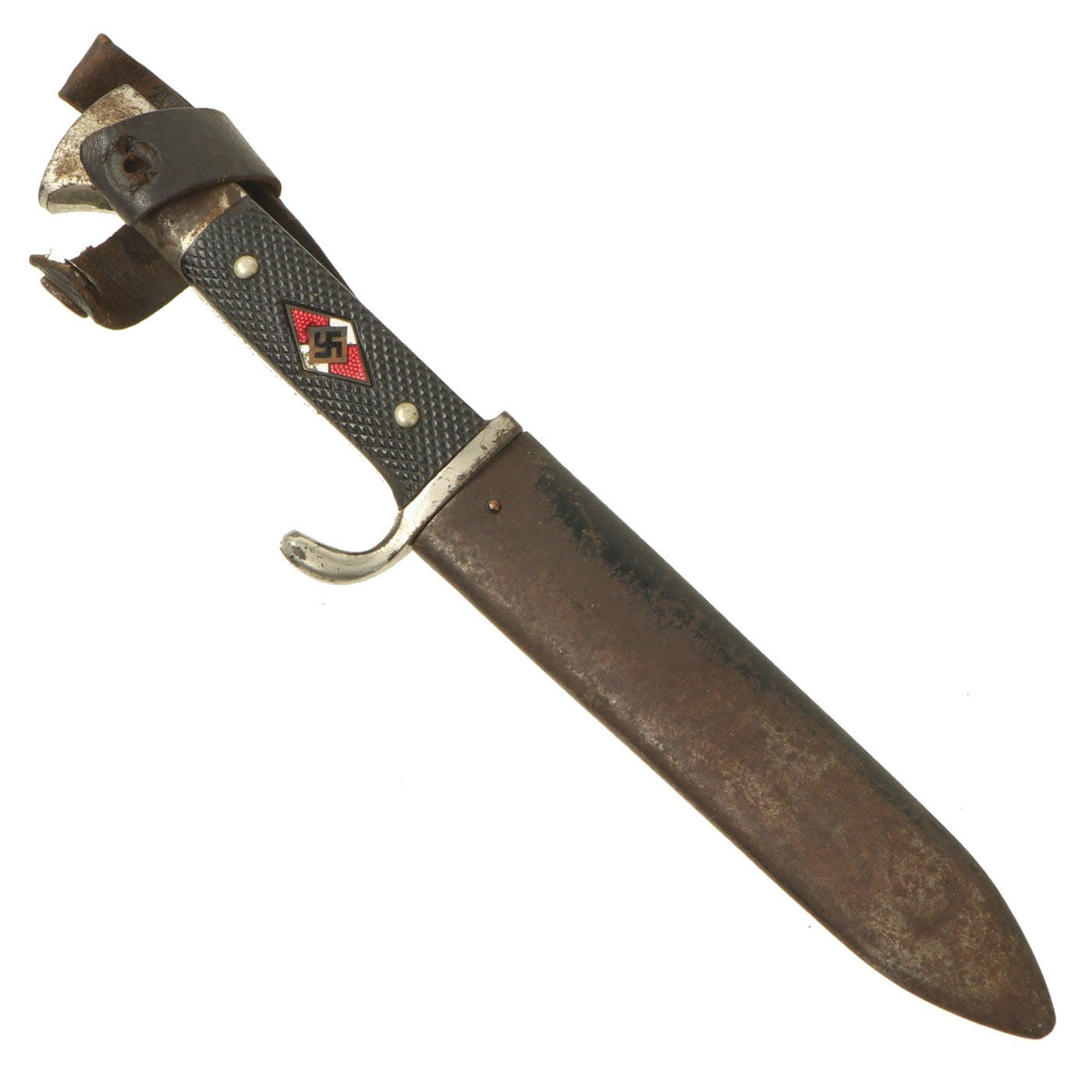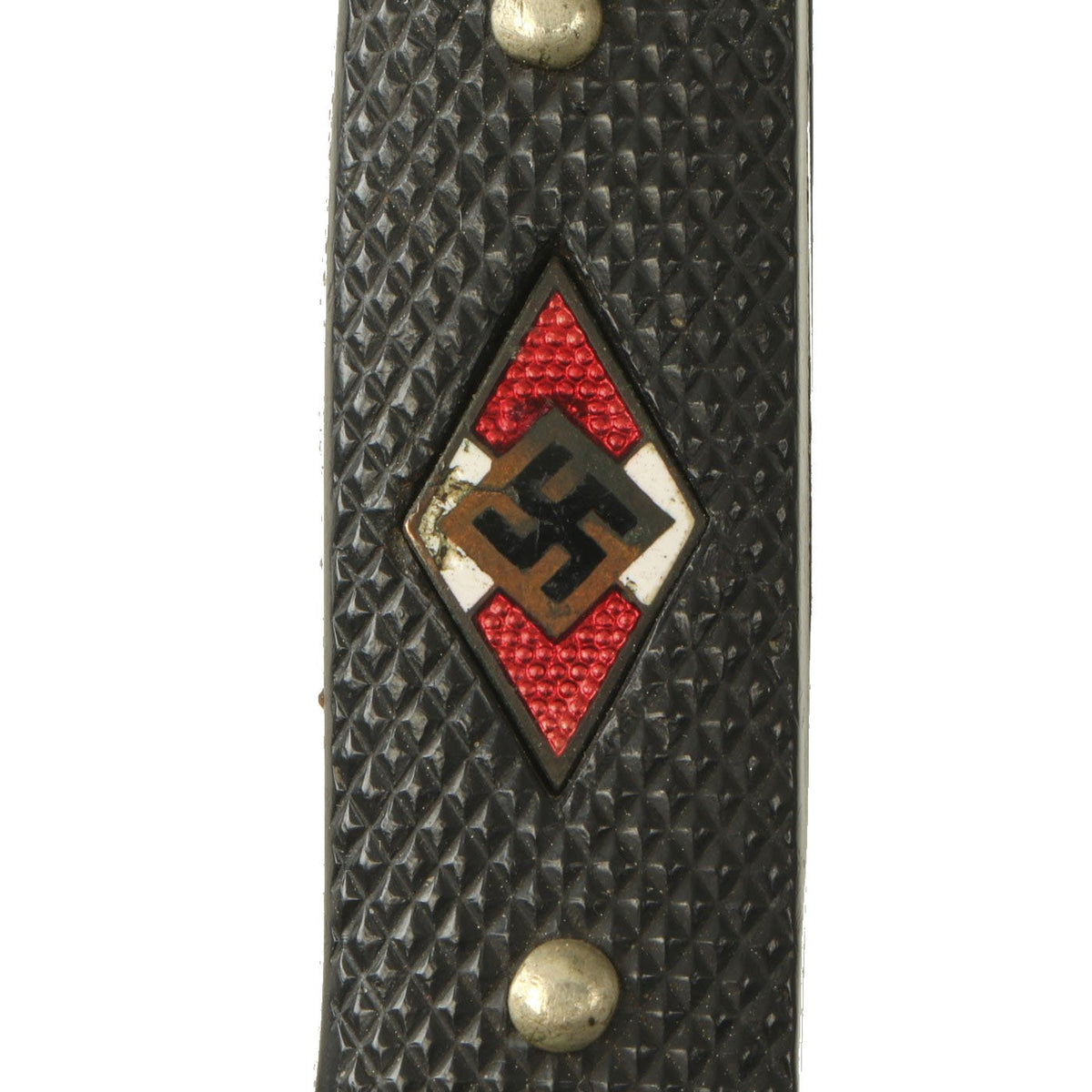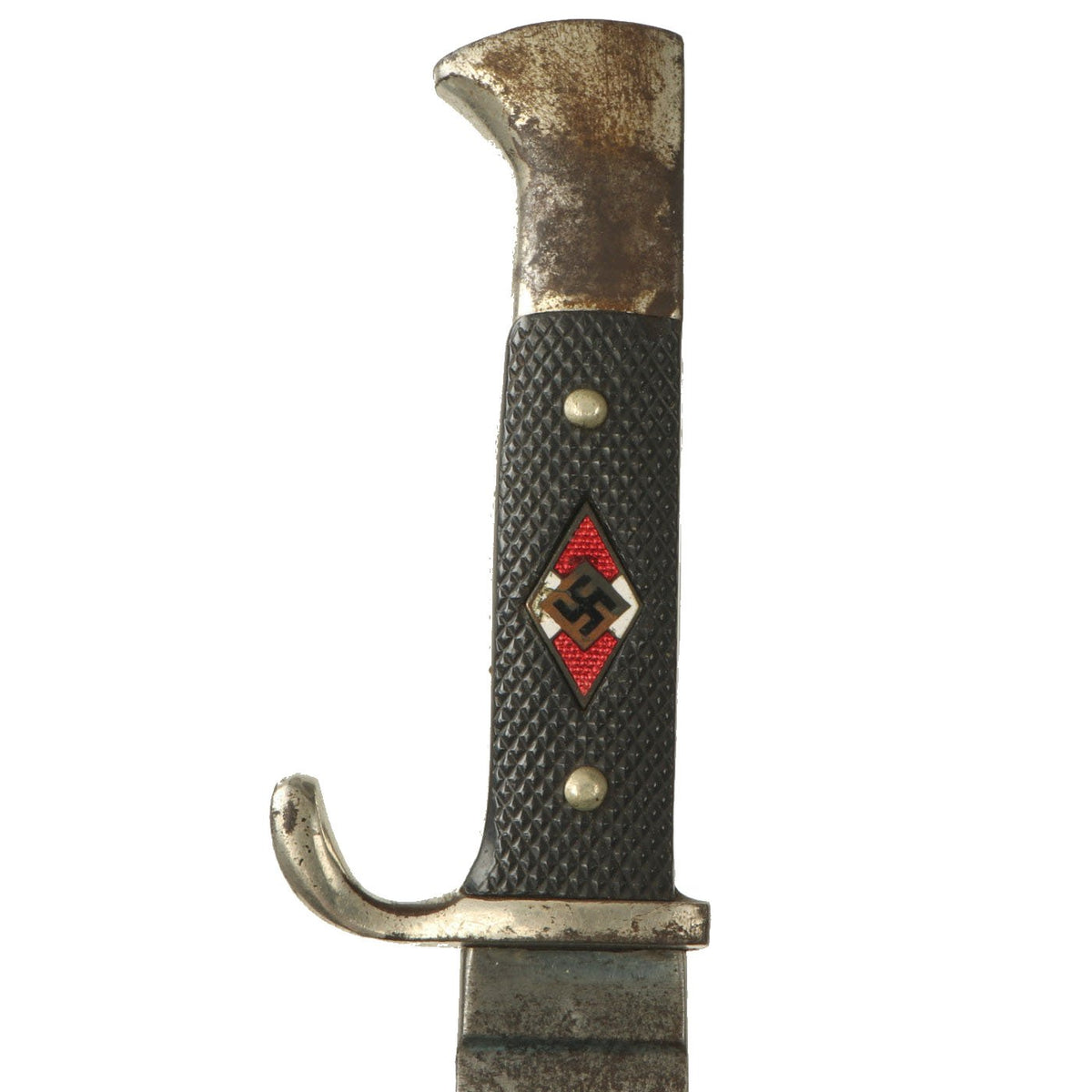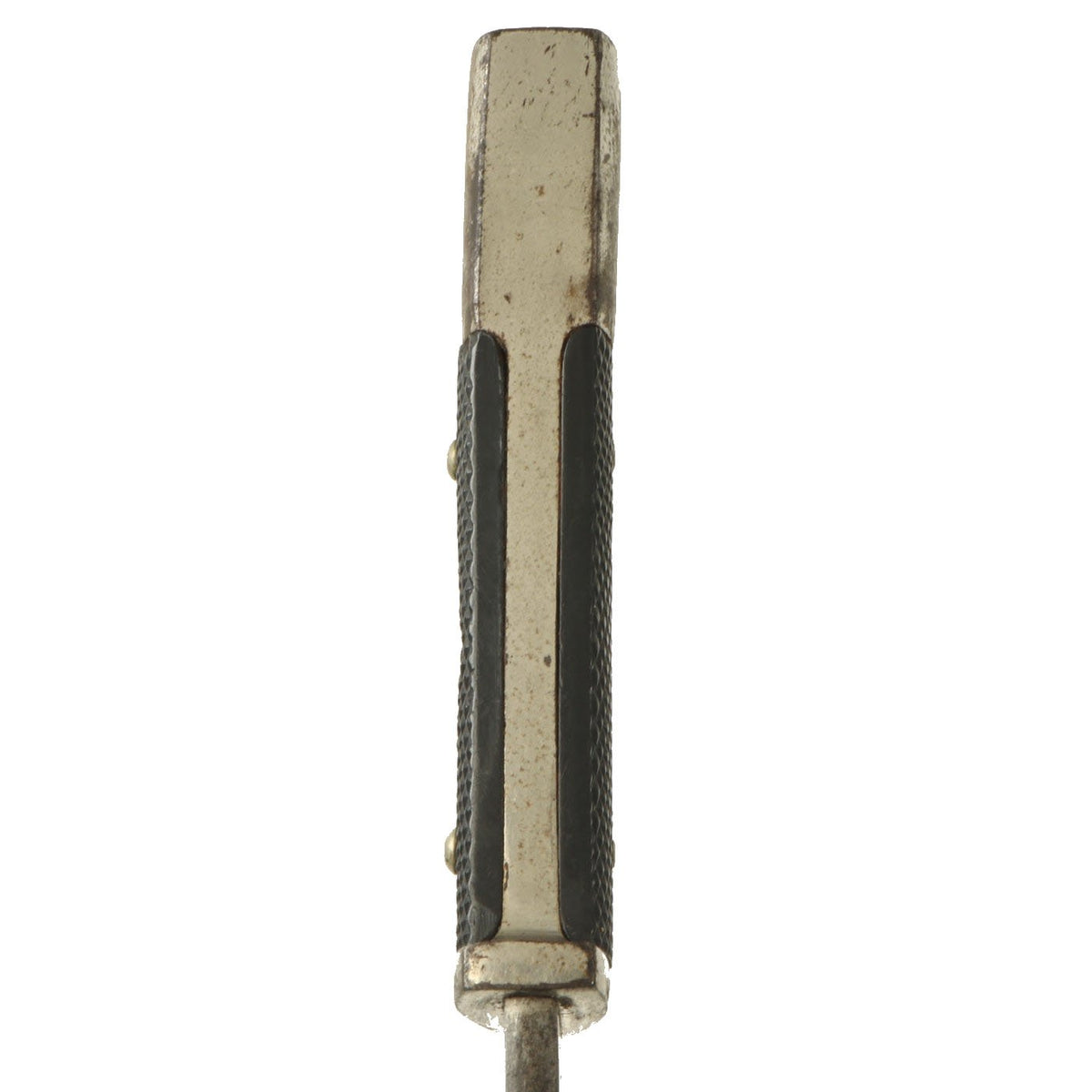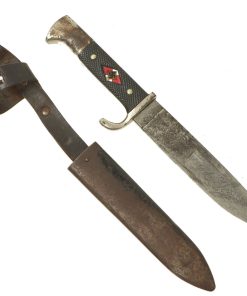Original German WWII 1936 dated Transitional HJ Knife with Motto by Emil Voos with Scabbard – RZM M7/2 Original Items
$ 495,00 $ 148,50
Original Item: Only One Available. This is a good condition pre-war production HJ Fahrtenmesser (HJ Trip Knife), marked on the blade with the RZM code of desirable maker Emil Voos, Waffenfabrik of Solingen. This is definitely a transitional period knife, based on the 1936 date as well as the motto. This HJ Knife is a solid example of the type, with a handle that is nickel-plated over a steel base. Much of the plating still remains, probably 60%, with the sides of the pommel missing a lot.
Unlike the early pattern knives, these have a thicker blade with a raised ricasso, which significantly strengthened the blade. However, acid-etched motto Blut und Ehre! (Blood and Honor!) is present though it is faint and only partially legible. Usually these later pattern knives did not have the motto, so this confirms it was made during the 1936-37 change over period.
The Bakelite grip plates are closely checkered and in very good condition, retained by nickel rivets with dressed obverse heads. The HJ insignia is also in very good condition with only a bit of wear, and with the enamel mostly intact. The plating on the brass has worn off, which is typical. The bakelite shrinks slightly over the years, which is why the logo is a bit sunken in and loose, confirming the authenticity.
The blade of this example is solid, with the strengthened ricasso, however it has been altered slightly from the original shape due to sharpening of the edge. It also shows staining and past rust speckling. This looks to be a knife that saw extensive use during the WWII period.
The reverse of the blade is very faintly marked with the RZM code for Emil Voos, over the production date:
((RZM))
M7 / 2
1936
Emil Voos, Waffenfabrik, also known as a Spezialfabrik für Jagd- und Sportmesser (Special Factory for Hunting and Sporting Knives), was a Solingen-based knife maker founded in 1925. They made many HJ knives during the WWII period, both with their trademark “Serpent Around a Stump” logo and later under their RZM code M7/2, per J. Anthony Carter’s work GERMAN KNIFE AND SWORD MAKERS.
The Reichszeugmeisterei, or RZM, was was based at the Brown house in Munich and NSDAP party headquarters in Berlin. The RZM ensured that the manufacturers of military items were consistent in design, quality of materials and other characteristics of the items. It also defined standards of design, manufacturing and quality and published an authoritative color chart for textiles. The M7 in the code stands for knives/daggers, contractor 2 stands for firm Emil Voos, Waffenfabrik, a maker from Solingen, the famous “City of Blades” in Western Germany.
The scabbard shell the typical tapered example, steel with a lovely worn finish. The scabbard looks to originally have been black enamel, but only about 25% of that is left, with the rest a nice oxidized patina, with no dents we can see. The leather hanger and belt loop are still present, and in nice condition, with the expected service wear. The retainer loop is also present, however the snap pulled out of one side, so it is no longer functional.
A very nice service used HJ Knife from the transitional period, made by a hard to find Solingen Maker! Ready to add to your collection and display!
Specifications:
Blade Length: 5 1/2″
Blade Style: Single Edged Knife
Overall length: 9 3/4”
Crossguard: 1 7/8”
Scabbard Length: 5 7/8” with belt loop
AH believed German youth to be the future of his 3rd Reich. The HJ (AH Jugend) was formed officially in 1935, and with the exception of NSDAP ideology indoctrination was very similar to the Boy Scouts. Beginning at about the age of ten years, both boys (AH Jugend) and girls (Bund Deutscher Mädel) were enlisted in the Party-run organization. The boys only were given HJ Knives after having passed minor exams. The knives had nickeled hilts with black checkered grip plates. The obverse plate was fitted with an enameled HJ swas insignia. Through 1937, these knives were etched with the motto of the organization, Blut und Ehre! (Blood and Honor!). Examples produced after this date were made with plain blades usually bearing an RZM marking.
The HJ Leaders were professionals in charge of the training and NSDAP education of the German Youth. They wore a special dagger consisting of silvered hilt fittings with blue-black leather-covered scabbard. The grip was composed of tightly wrapped silver wire, over a wood base. The pommel cap featured an HJ diamond on top, complete with swas. The upper scabbard fitting portrayed an open-winged HJ eagle with swas cut into the bird’s chest. The blade was etched with the HJ motto, Blut und Ehre!
Fast Shipping with Professional Packaging
Thanks to our longstanding association with UPS FedEx DHL, and other major international carriers, we are able to provide a range of shipping options. Our warehouse staff is expertly trained and will wrap your products according to our exact and precise specifications. Prior to shipping, your goods will be thoroughly examined and securely secured. We ship to thousands clients each day across multiple countries. This shows how we're dedicated to be the largest retailer on the internet. Warehouses and distribution centres can be located throughout Europe as well as the USA.
Note: Orders with more than one item will be assigned a processing date depending on the item.
Before shipping before shipping, we'll conduct a thorough inspection of the items you have ordered. Today, the majority of orders will be delivered within 48 hours. The delivery time will be between 3-7 days.
Returns
The stock is dynamic and we cannot completely manage it because multiple stakeholders are involved, including our factory and warehouse. So the actual stock may alter at any time. It's possible that you may not receive your order once the order has been made.
Our policy is valid for a period of 30 days. If you don't receive the product within 30 days, we are not able to issue a refund or an exchange.
You can only return an item if it is unused and in the same state as the day you received it. You must have the item in its original packaging.
Related products
Uncategorized
Uncategorized
Armoured Fighting Vehicles of the World: AFVs of World War One (Hardcover Book) New Made Items
Uncategorized
Uncategorized
Band of Brothers ORIGINAL GERMAN WWII Le. F.H. 18 10.5cm ARTILLERY PIECE Original Items
Uncategorized
Uncategorized
Uncategorized
Uncategorized
Angolan Rebel 1970s era 60mm Inert Display Mortar from Angolan Civil War Original Items
Uncategorized
Uncategorized
Uncategorized
Australian WWII Owen MK1 Machine Carbine SMG Custom Fabricated Replica with Sling Original Items
Uncategorized
Uncategorized
Uncategorized
Armored Burgonet Helmet & Polearm from Scottish Castle Leith Hall Circa 1700 Original Items
Uncategorized
Uncategorized
Uncategorized
Uncategorized
